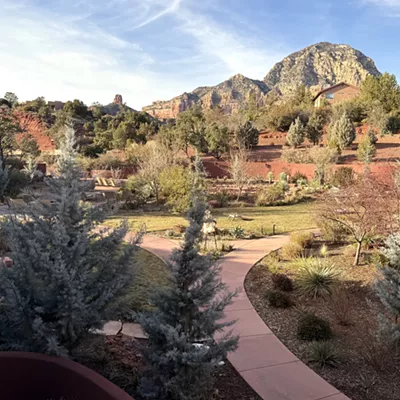During Tucson's ungodly hot summers, there are creative ways to get out of the sun.
Beyond the movie theaters and ice cream shops, there are other places Tucson residents and visitors can frequent that will take them off the beaten path for a fairly small amount of money.
Those places? Caves.
Yes, caves. Southern Arizona has two cave systems that are nationally renowned and home to thousands of visitors every summer.
Colossal Cave is located just outside of the Tucson city limits, near the growing Vail area. Used for more than 1,000 years, the cave system holds an air of mystery and intrigue, with about three miles of passages—not counting as-yet unexplored parts—and multiple entrances and exits that provided a sanctuary for outlaws and bandits in the 1800s.
"You can come out here several times and have a different experience each time," says Lauren Hohl, Colossal Cave's education coordinator. "It's definitely more than just a trip outside of town."
Although Colossal Cave tours have been in full force since 1923, Hohl says cave officials take pride in the relatively undisturbed nature of the cave system.
"The park is kept primitive on purpose," she says.
The best part for visitors ailing from the summer heat may be Colossal Cave's friendly climate, which stays dry and cool, with temperatures steadying around 70 degrees.
"It's really comfortable. You can go out, but still be in," Hohl says.
Not to be outdone, Arizona State Parks' Kartchner Caverns is a prime destination for cave enthusiasts from around the world, says Ellen Bilbrey, public information officer for Arizona State Parks.
Located less than 50 miles away from Tucson, near Benson, Kartchner opened as a state park about 20 years ago, with the understanding that its vast caves would be such a crowd-pleaser that it would create enough revenue to stay open and prosperous, Bilbrey says.
That idea has turned into a reality, as Kartchner is one of the few state parks to stay open without the assistance of a third party or other state funds.
Although the caverns carry a high humidity rate, they also stay around 70 degrees, a far cry from the triple-digit temperatures Tucsonans see in the summer.
Unlike Colossal Cave, which is dry and dormant, Kartchner Caverns is a "live" cave system, meaning it has enough water and humidity to house various bacteria and creatures.
"It's like a living organism, actually," Bilbrey says.
Because the cave system is "alive," cave researchers on the cutting edge of science study Kartchner, says Bob Casavant, science and research manager for Arizona State Parks.
Arizona State Parks has partnered with University of Arizona scientists and students to explore various aspects of the caverns' life system. The scientists' research is highly interactive with Kartchner visitors; team members often talk to tours about their ongoing work within the caverns, Casavant says. "The public sees the research in progress."
This commitment to both science and public attraction makes Kartchner Caverns a beloved area for Arizonans yearning to see their state doing good things, Casavant says.
"Arizona has much to be proud of in its development, study and advancement of Kartchner Caverns," he says.
Pima County-owned Colossal Cave is no stranger to science, either. Reflecting the cave's rich system of animal life, the National Geographic Wild cable channel stopped by Colossal Cave on May 18 to take a look at bat bugs and other creatures for The Invaders, a natural-history series that chronicles various invasive species and parasites that come into conflict with other animals, says Justin Weinrich, a producer for the show.
Whereas bed bugs invade the homes of humans, bat bugs are the cave equivalent, wreaking havoc on bat species.
"Bed bugs are a big story right now," Weinrich says. "And the cave has all the ingredients we need to film with."
The film crew's presence at Colossal Cave will hopefully give the cave and surrounding park some exposure and publicity going into the summer, showing potential visitors some interesting and intricate aspects of the cave's system of life, says Martie Maierhauser, Colossal Cave's park director.
"They want to draw parallels that there are other species that are having the same problems (as humans)," says Maierhauser, who stresses that cave visitors cannot catch bat bugs from the tours. "Bed bugs creep people out."
Averaging about 100,000 visitors each year, Colossal Cave runs about 12 tours a day, with 15 to 20 visitors making up each tour. Regular cave tours require no reservations, but reservations are required for Colossal Cave's more physically demanding tours, including the Ladder Tour and Wild Cave Tour, which take visitors beyond the regular passageways.
About a half-mile long, Kartchner Caverns' Rotunda/Throne Tour, available with a reservation, takes wanderers about an hour and a half to complete.









